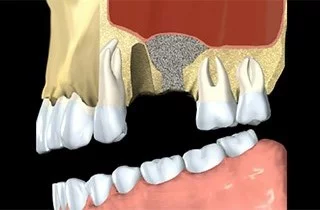Jawbone loss often goes unnoticed in many people – often painless, but with serious consequences. This condition not only jeopardizes the stability of the teeth but can also impair overall oral health in the long term. But what exactly causes jawbone loss, how can it be detected in time, and what can be done about it? This article is aimed at anyone who might be affected by jawbone loss due to periodontitis, tooth loss, or other causes and wants to learn more about the causes, the signs of recognition, and the treatment options for rebuilding or preserving bone mass.
In this article, you will read about the following: 
- What are the symptoms of dental bone loss?
- What are the causes of dental bone loss?
- Can teeth with bone loss be saved?
- Can you increase bone density after 30?
- Can you reverse dental bone loss?
What is dental bone loss?
Jawbone loss is in some ways similar to osteoporosis, as both involve the loss of bone mass, but they occur for different reasons and with different mechanisms of action. This condition causes a reduction in bone mass. In general, bone loss throughout the body is caused by nutritional deficiencies and lack of exercise. In contrast to general bone loss, other causes are responsible for bone loss in the jaw (also called jawbone loss).
What are the symptoms of dental bone loss?
In general, jawbone loss is very inconspicuous because it progresses painlessly. However, in the end, the entire jaw becomes less resilient. In an advanced state, you may notice the following symptoms: 
- gums bleeding when brushing teeth,
- red, swollen, and/or sensitive gums,
- bad breath,
- loose teeth,
- changes in how the teeth fit together.
What are the causes of dental bone loss?
Jawbone loss most often occurs as a result of periodontal disease or after the loss of several teeth that have not been replaced. Periodontitis is a gum disease. Poor oral hygiene can contribute to the development of jawbone loss, especially when combined with factors like genetic predisposition or advanced age. Oral Hygiene If this inflammation is not treated in time, it develops further into periodontitis, which ultimately leads to the breakdown of the jawbone.
Can teeth with bone loss be saved?
Yes, treating jawbone resorption can in many cases slow down or partially reverse the process, but the outcome depends heavily on the severity of the damage and the methods applied. Early intervention and the right treatment can help stabilize the condition and prevent further damage. Here’s how: Periodontal (gum) disease treatment: A deep cleaning procedure to remove plaque and tartar from below the gums, helping to reduce infection and inflammation. Topical or oral antibiotics may be used to treat bacterial infections. Some dentists use laser treatment to remove bacteria and promote healing. Gum grafts for receding gums: In cases where gum recession is contributing to bone loss, a gum graft can help restore gum tissue, and protect and stabilize the teeth. Splinting Loose Teeth: For severely loose teeth, dentists may use splinting techniques to brace weak teeth, providing additional support and preventing further movement.
Can you increase bone density after 30?
Yes, you can increase bone density after the age of 30, but it becomes increasingly difficult as bone mass naturally declines. Although the potential for bone building is highest before the age of 30, it is still possible to increase or maintain bone density into adulthood with consistent attention and a healthy lifestyle. Eat for strong bones: Consume foods rich in calcium and vitamins D and K, and Magnesium. Weight-bearing and strengthening exercises: Activities such as walking, jogging, dancing, and resistance training stimulate bone turnover. Lifestyle changes: Quit smoking and limit alcohol, maintain a healthy weight. Regular checkups and bone density tests: A DEXA scan can assess bone health and help track progress.
Can you reverse dental bone loss?
Yes, dental bone loss can sometimes be reversed or treated, depending on the severity and cause. Here are some approaches:
Bone grafting: If bone loss has occurred due to missing teeth or periodontal disease, bone grafting can help restore the lost bone. This involves placing natural or synthetic bone material into the affected area to stimulate new bone growth. Guided bone regeneration (GBR): This procedure uses barrier membranes to encourage bone regeneration, especially in preparation for dental implants. It helps prevent soft tissue from growing into bone defects, allowing new bone to form. Dental Implants and Osseointegration: When a dental implant is placed, the jawbone can naturally fuse with the implant through a process called osseointegration, which can help maintain and even stimulate bone growth.
Platelet-Rich Plasma (PRP) Therapy: PRP uses growth factors from the patient’s own blood to speed up bone healing and regeneration. Medications and Supplements: Certain medications, such as bisphosphonates, can slow bone loss in osteoporosis. Calcium and vitamin D supplements also contribute to overall bone health. Preventing further bone loss: Early treatment of gum disease: Prevents bone damage caused by bacterial infections. Tooth replacement prevents further bone loss due to missing teeth by maintaining stimulation. Daily brushing, flossing, and regular dental checkups can prevent periodontal disease, which is a major cause of bone loss. Read more about stopping jawbone loss and jawbone augmentation costs, After a bone augmentation
Although severe bone loss is difficult to reverse completely, modern dental treatments can restore function and improve bone density, allowing a strong, healthy jawbone to be rebuilt.


